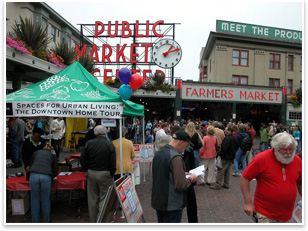
Livable Communities: A Multidisciplinary Dialogue on Designing a Sustainable Future
Summary: AIA members joined forces with regional and city planners, urban foresters, ecologists, economists, demographers, developers, and elected officials to explore “livability and sustainability” across America at the Livable Communities: Walking, Working, Water Conference in Seattle, September 14–17. “Walking, Working, Water” served as an analogy representing the intersecting spheres of community—social, economic, and environmental. Participants agreed that it will take a coordinated and focused regional approach to marshal the visionary civic leadership, engaged citizenry, and an enlightened private sector needed to create an appropriate model for a more livable and sustainable tomorrow. We discovered common goals and forged an agenda to move the AIA’s continuing commitment to livable communities forward.
They also recognized and celebrated the vital role design plays in shaping our urban regions. Universal principles; local applications
Participants formally acknowledged support of AIA Seattle’s position for removing the unstable Alaskan Way Viaduct, the elevated highway paralleling the downtown’s central waterfront. A recent study by the Center for Neighborhood Technology, presented at the conference, demonstrated that traffic could be redistributed across a replacement surface arterial and adjoining streets network.
As AIA Seattle’s President-elect Lee Copeland, FAIA, noted, “Seattle
residents can live, work, and play without going anywhere.” That’s
an enviable position, and one that is certainly achievable by rediscovering
America’s traditional urban regions through design solutions. |
||
Copyright 2006 The American Institute of Architects. All rights reserved. Home Page |
||
news headlines
practice
business
design
Randolph Jones, AIA, AICP, The Jones Payne Group, Boston, is vice chair of the AIA’s Regional and Urban Design Committee.
Photos by the author.
“America at the Livable Communities: Walking, Working, Water,“ the most recent annual Livable Communities conference, was sponsored by the AIA Regional and Urban Design Committee, Center for Communities by Design, Committee on the Environment, Housing and Custom Residential Committee, and Young Architects Forum; AIA Seattle; USDA Forest Service; and AARP.
For a local perspective, read AIA Seattle’s report by Marga Rose Hancock, Hon. AIA.
A
printer-friendly version of this article is available.
Download the PDF file.


 Livable communities can be supported by recapturing a sense of community,
connectedness, and convenience through compact walkable development,
mixing of uses, and creating places for gatherings and celebration.
This can be achieved through making streams pedestrian-accessible,
restoring and protecting urban forests, developing heritage parks
and museums, protecting local farmland and creating farmers’ markets,
creating mixed-use transit-oriented development, recapturing urban
waterfronts, revitalizing aging downtowns, providing affordable housing
and neighborhood schools, and planning events.
Livable communities can be supported by recapturing a sense of community,
connectedness, and convenience through compact walkable development,
mixing of uses, and creating places for gatherings and celebration.
This can be achieved through making streams pedestrian-accessible,
restoring and protecting urban forests, developing heritage parks
and museums, protecting local farmland and creating farmers’ markets,
creating mixed-use transit-oriented development, recapturing urban
waterfronts, revitalizing aging downtowns, providing affordable housing
and neighborhood schools, and planning events. Thinking beyond green
Thinking beyond green Seattle: The ideal urban venue
Seattle: The ideal urban venue